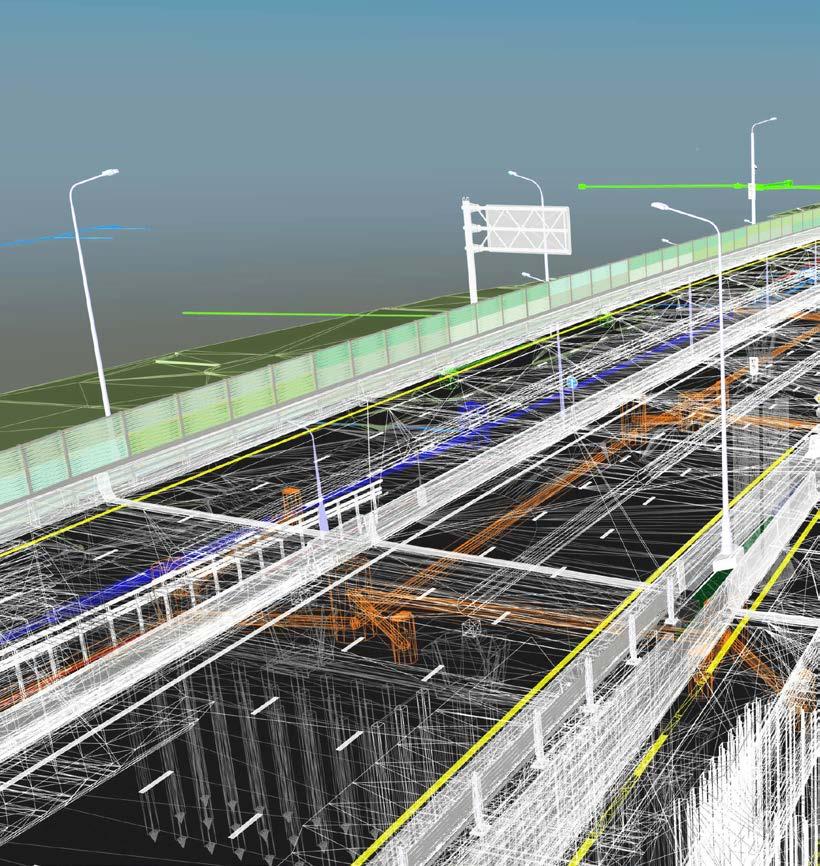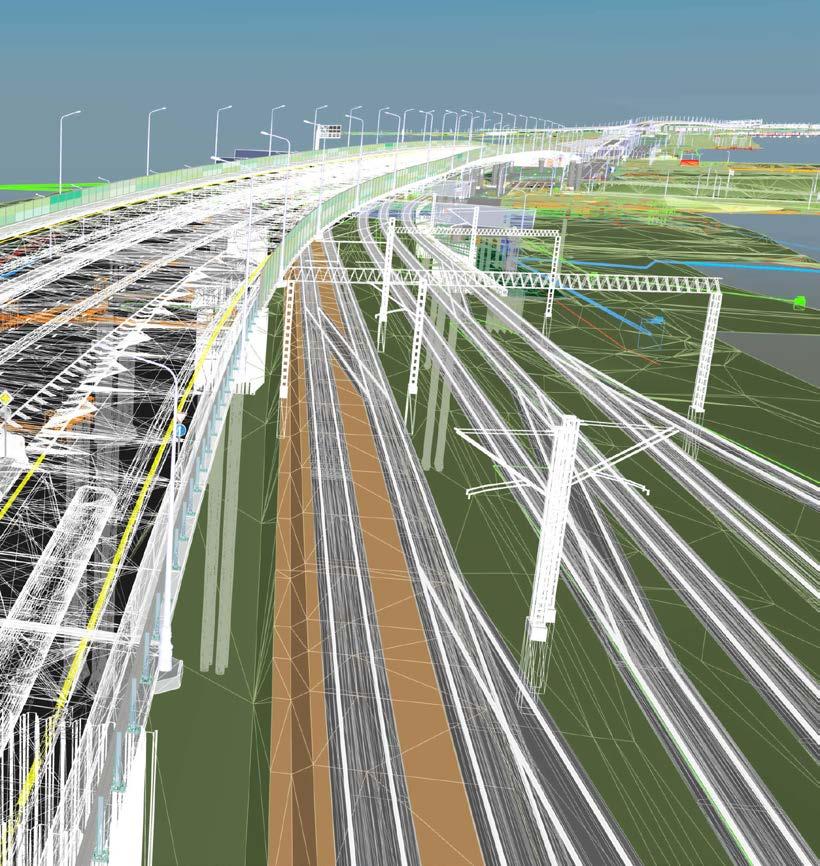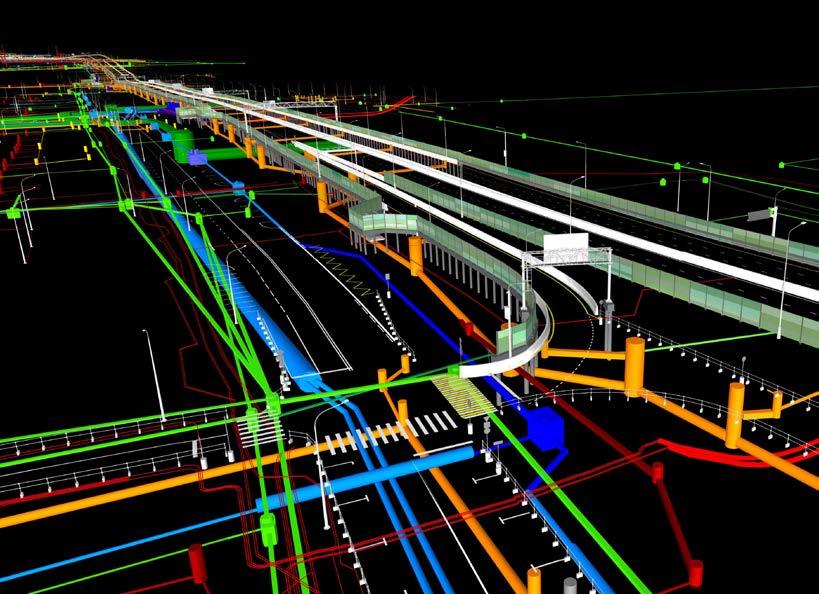
7 minute read
Evolving Digital Delivery: Why Switch to the Model of Record
By Andrew Poszich, PE
Where are you and your colleagues on the journey to digital transformation?
Never before have we been tasked with creating, managing and interpreting the sheer magnitude of generated data. Our industry, among others, has seen a massive influx of new ways of storing information, evolving from paper plans to PDFs, electronic transmittals, and now digital delivery and beyond.
Digital delivery workflows expedite delivery times and design efficiencies early in the project lifecycle. The true potential comes to light when that same data is being used (and certified) through construction. Leveraging the same model data provides insight into reducing potential conflicts in the field before they happen, improves the understanding of design intent, and leads to a safer, more efficient construction and inspection process.
Inherent in all digital delivery workflows, real-time quality control allows you to oversee the design progression in a way that may not have been feasible in the past. Automated tools such as clash detection make it much easier for the project to progress and see where the issues may lie. As the project evolves, you can comment, advise, and even pivot if something isn't meeting the desired outcome.
With a fully matured digital workflow, you're not losing information or redoing work as you hand off data through different stages of the project lifecycle. Minimizing restarts each time you go from one major project milestone to the next can save significant time – and cost. You are ultimately working towards a future where you can keep information continuous and constantly evolving throughout the asset's lifecycle.

Using 3d Design Data
Delivering projects in 3D provides a lot of usable data and benefits. One of my favorite benefits of using a 3D model is that it saves me time and understanding regardless of which phase I’m being brought into a project. I'm not piecing together different items, plan sheets or ideas; instead, I can see every component as it is and how they will interact.
Another underleveraged tool I’ve seen is the use of reality mesh data to enhance traditional survey deliverables. A reality mesh is a great tool that brings in that elevated level of information about your existing conditions and embraces the understanding of working in a 3D world.
Most importantly, the 3D model eliminates any misinterpretation. You're working in a geospatially accurate 3D space with a single source of truth to push your designs and projects forward. With that comes an increased emphasis on inner interdisciplinary coordination.
Since you're relying on that single source of truth for the model information, you start seeing the benefit of this passive quality control environment where you're inadvertently looking over the shoulders of your neighbors (other disciplines) in the 3D model, able to see changes in real time. While this does not replace a formal QC process, it greatly enhances coordination as you develop the design.
3D Visualization isn't something new; it's been around for years. But now you have an integrated model that is part of your design process that can quickly be brought forward for public involvement or stakeholder meetings. You can zoom into those areas they care about and even drop down to show the street view and walk through the project.

It's essential not to get overwhelmed with the data, and it's also necessary to be aware that not every project is the same. For instance, in the transportation sector, how you manage the 3D design on an intersection project could be very different from that for a 10-mile new alignment.
Moving Towards A Model Of Record
Using models as legal documents (MALD) is a vision of digital delivery that is being leveraged by many agencies and firms across the country. Having the 3D model serve as the contract document solves a key piece of the information lifecycle puzzle. Even if projects currently provide a model as part of the contract package, it often can’t be used for the actual construction beyond field validation if it's not contractually binding.
Something easily overlooked is whether state legislation allows for this type of project delivery - this is something to research if you’re looking to implement it at the state agency level.
In Florida, digital delivery is the standard method of electronically transmitting contact documents to FDOT. Digital files specifically created for automated machine guidance (AMG) and inspection are being signed and sealed in addition to contract plans.
Starting your digital delivery journey without using a full 3D model is OK. Consider starting by sharing alignments and Land XML files, as this will get partners around you used to working with these tried and tested file types. Land XML has been around for years and is used by contractors and inspectors, as it works with several operating platforms in the field.
Try to be agnostic with the programs that provide your data, as you don't want to be locked into a specific platform as tools and technologies change. Keep your policy focused on the information you have and not necessarily the platform it was produced with.
As you incorporate digital delivery workflows in your agency, it's important to continue engaging with our industry. Recognize that you are in the spotlight if you're near the front of the pack, signing, sealing, and leading these pilot projects. Other states and agencies are looking to you for guidance and advice, whether they're directly contacting you or not.
We encourage you to attend technical conferences, mingle with people doing the work, and focus on sharing the information you discover. Communication is key to digital delivery. You can never over-communicate. BIM provides an excellent common language we can all readily converse in and understand once those connections are established.
These are conversations we all need to have with each other as we move our industry toward digital delivery. The results will be more collaboration, improved quality control, and better projects for everyone.
Implementing a Digital Workflow
The tools you'll need to get started with digital delivery are readily available, making it simple to start leveraging them to develop your digital review workflows. As you jump in, remember that you don't have to rush. Here are a few things to consider:
The horizon, as defined by digital delivery, is broad, so prioritize things that matter most to your firm or agency.
Begin with readily available deliverables to your group so you can start leveraging and seeking those benefits and values sooner.
Consider interagency partnerships and partnering with consultants, contractors, inspectors, and other stakeholders. Get feedback, see what people are using, and start incorporating what is critical and beneficial for you.
Integrate those deliverables into the plan delivery process.
Most importantly, communicate the rollout, explaining not only what you're doing, but why you're doing it and the steps you're taking.
Remember, this is a commitment to a process, so take it one step at a time. And remember that partnership is critical through all this, as we're all in this process together.
Andrew Poszich, PE has been with RS&H since 2014 and serves as the Design Integration Lead for the Transportation Market after spending many years in the highway design group. He brings an in-depth understanding of transportation design and overall three-dimensional workflow as it relates to core engineering principles and interdisciplinary collaboration. He can be reached at andrew.poszich@rsandh.com.







